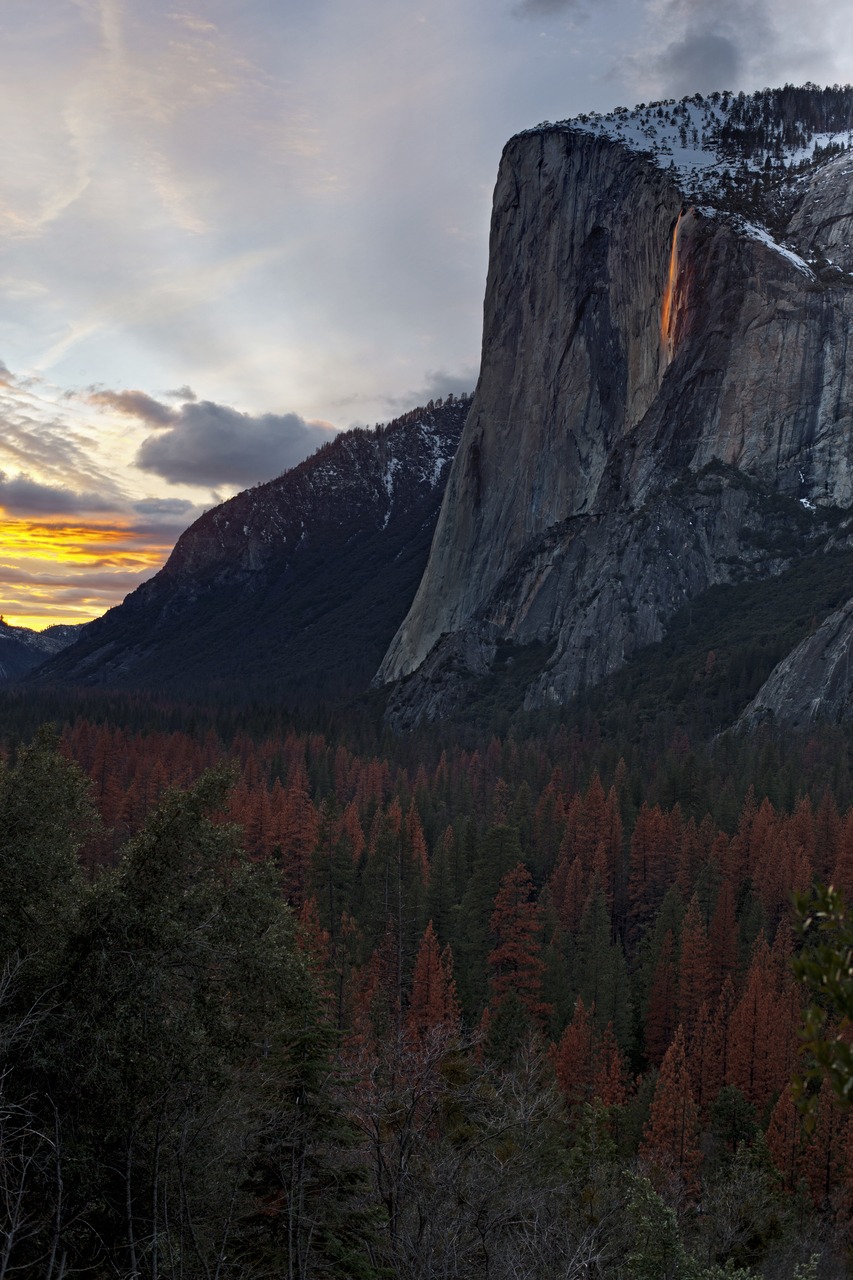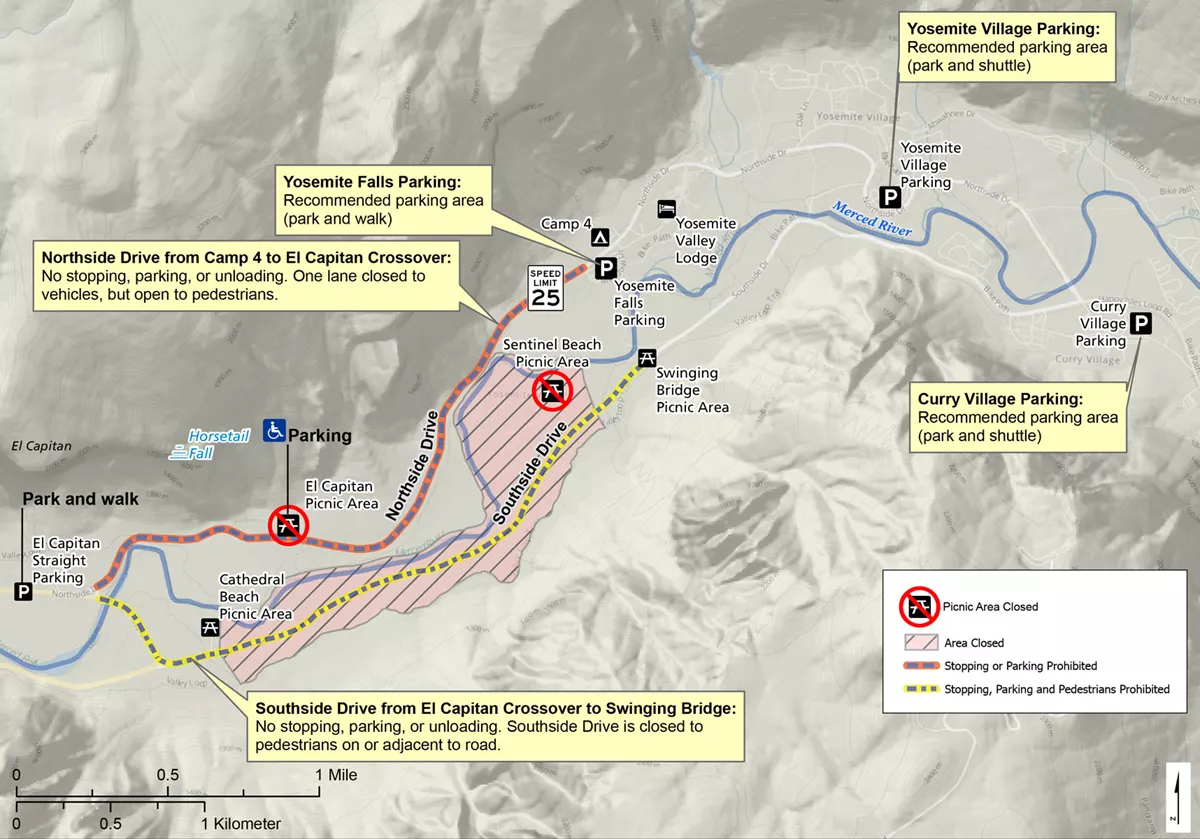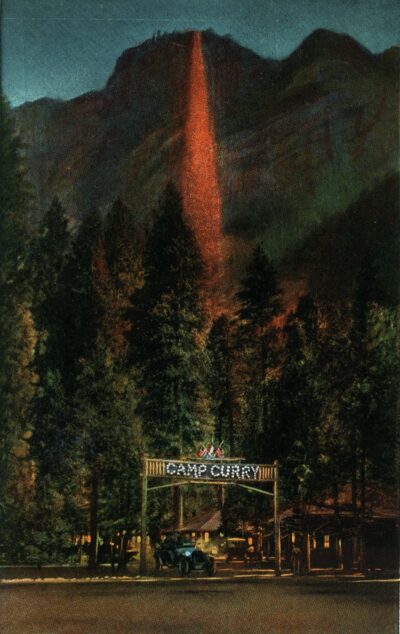The information below is for 2026, last updated in December 2025. We will continue to update this page if additional information becomes available.
The Horsetail Fall event is a natural phenomenon that has grown in popularity in recent years. Horsetail Fall is an ephemeral waterfall that appears to glow as if on fire when the light hits it, and conditions are right in late winter.
Continue reading to learn what you need to know regarding reservations, traffic and congestion in the park, conditions are needed to see the full “firefall” effect, and the history of the original Yosemite Firefall and the connection to Horsetail Fall.
2026: Reservations have not been announced!
In recent years, Yosemite National Park has put in place entrance reservations to limit crowding during this popular event. The park has not yet announced if there will be reservations in place in 2026.
Regardless of whether or not a reservation system is in place, we encourage you to plan accordingly.

Horsetail Fall aglow in February 2017. @damoncorso
Plan Ahead:
- Make sure that you have all necessary information and that you know about restrictions during the event.
- Check the Yosemite Valley weather forecast for snow and clouds.
- Dress in warm layers and maybe pack a warm beverage and a few snacks. To have a good view of the fall, you’ll likely need to hike a few miles out to a viewing area. Being appropriately prepared for the cold will help keep morale up.
- Expect to park far from the Horsetail Fall viewing areas and prepare to either:
- (a) Hike the ~1.5 miles to the Horestail Fall viewing areas from Yosemite Falls Parking, just west of Yosemite Valley Lodge. Please stay on the trail/designated pathway (aka on the road when you see signage) when walking to the viewing areas.
- (b) Ride the Yosemite Valley-wide Shuttle, which will most likely be very full during this event, so give yourself extra time to wait for a bus.
- Pack a headlamp or flashlight for your return trip. Getting to the viewing area is only half the fun, you still need to hike back — after sunset.
- If you do need help in the park, stop by our Conservancy volunteer crew’s blue information booth, located at the west end of the Yosemite Lodge/Falls parking lot. They will also be set up at the viewing area to provide you with the most up-to-date information.
Protect the Park:
- Stay on trail and out of sensitive habitat. As the popularity of this annual event has increased, so have its impacts on the vegetation and wildlife in the area. Please follow directions to minimize erosion to riverbanks and destruction to meadows.
- Listen to all park staff and volunteers. They are there to make sure everyone stays safe and to protect park resources, such as sensitive meadow vegetation.
- Dispose of waste properly. Vault toilets, along with trash and recycling dumpsters, are available at the El Capitan Picnic Area. Be sure to pack in and pack out any trash from the viewing area to minimize your impact on wildlife.
- Practice the Leave No Trace principles. In addition to the principles listed above, remember to leave what you find, follow park restrictions, respect wildlife, and be considerate of others.

Horsetail Fall event map. Courtesy of NPS
What is the Horsetail Fall event?
Horsetail Fall is an ephemeral waterfall that falls over an eastern ridge of El Capitan in Yosemite National Park. It typically only flows in the winter months.
In February, there is a period of time when (if) conditions perfectly align at sunset, the waterfall is illuminated in such a way that it appears to radiate its own light.
There are a certain number of atmospheric conditions that are required for the “flow to glow,” including:
- Horsetail Fall must be flowing. If it’s a particularly cold year or dry year, there may not be any water on the waterfall. No ephemeral waterfall can be trusted. Just ask visitors in August how they feel about Yosemite Falls.
- The sky must be clear. If there is any haze or cloud cover, the glow will be either greatly diminished or non-existent.
- Even when the conditions align perfectly, the actual glow in the flow of Horsetail Fall occurs for a short window of time during sunset. And then the sun will have set, and it will be both colder and darker than it was moments before.
- AND on top of all that, please note that many photos that are circulated online have been digitally enhanced.
The History of the Horsetail Fall event
Park rangers and officials will never refer to the Horsetail Fall event as the Yosemite Firefall, though this is the name that most other websites and YouTube videos will use. All of the park’s messaging (and ours) refers to this event as the Horsetail Fall event or the Horsetail Fall phenomenon.

Historic postcard depicting the historic Yosemite Firefall from Curry Village. Image of YOSE 079431 courtesy of NPS.
The Original Yosemite Firefall
Yosemite National Park saves the word Firefall specifically for the historic event which occurred from approximately 1872 to 1968, where embers from a bonfire were pushed over Glacier Point. In its heyday there was a ritualized routine to the event where spectators would gather in the Valley meadows to behold. Every summer evening there would be a call and response:
“Hello Glacier Point!”
“Hello Camp Curry!”
“Is the fire ready?”
“The fire is ready!”
“Let the fire fall!”
Read more about the human-created spectacle in this Backpacker article: The Original Yosemite Firefall Was a Bonfire Pushed Off a Cliff by Adam Roy.
The Origins of Today’s Fiery Phenomenon
According to an article from the Ansel Adams Gallery: “Even before its fame, the waterfall drew the attention of Ansel Adams, who photographed it in his traditional palette of grays around 1959. But for the most part, it flowed with anonymity while casual observers passed it by; that is until a young climber and photographer named Galen Rowell changed the course of history.”
The current Horsetail Fall event was originally captured on color film by a young climber named Galen Rowell in 1973. The Ansel Adams Gallery retells the story behind the image “Horsetail Fall by Galen Rowell.”
Thanks to the internet and social media, the Horsetail Fall event has grown to attract thousands of people annually in search of this contemporary, au natural, phenomenon.
According to Yosemite National Park, “This event attracts many visitors to a small area, causing traffic congestion, parking issues, safety concerns, and impacts to natural and cultural resources.” In years without reservation systems, it is up to us to carefully steward the landscape as we gather to enjoy this special event.
As crowds have grown during the day in recent years, some photographers are getting creative with their approach. With the rise in popularity in astrophotography, some photographers have succeeded in capturing the Horsetail Fall illumination by moonlight.
What else is there to do in Yosemite in February?
- Yosemite Village stays open year-round. The Yosemite Museum, Ansel Adams Gallery, and Yosemite Exploration Center are great places to learn more about the natural and cultural history of Yosemite National Park – while staying warm inside!
- On good snow years, Yosemite Hospitality runs Badger Pass Ski Area. This historic ski area was almost the site of the Winter Olympics. Learn more about Yosemite’s Alternate Histories.
- Check out the Conservancy’s Yosemite in Winter blog for more information on activities (indoor and outdoor) and other winter travel tips.
Header Image: Horsetail Fall at Sunset by Conlon Creatives.
